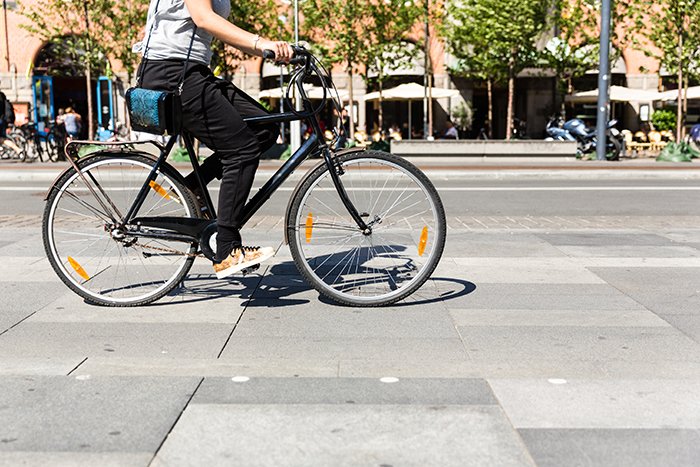
Pedaling forward for 40 years
When Memphis magazine first appeared on newsstands and in mailboxes, I didn’t read it. I turned 6 years old in 1976, the first year of Memphis, and I was busy learning to ride my bike across a weedy patch of lawn in front of my family’s small bungalow on Central Avenue in Midtown.
I would ride a parade of bicycles through elementary and high school but, as a child of the 1970s, I was promised jetpacks and flying cars as a means of travel into the distant future. Those promises have yet to be realized and, at 45 years old, I instead rode my bike to work today.
Who’d have thought that my simple, two-wheeled conveyance of childhood would be the best way to meander through the twenty-first century?
Apparently, Memphis magazine thought so. For an essay from the June 1976 issue on bicycling in the city, Max Heine wrote, “More and more Memphians are discovering the bicycle to be a clean, economical, and practical transportation vehicle, as well as an increasingly popular form of recreation.”
But that was 1976, a time of great sprawl as the city crawled its way east. Heine wrote, “Unfortunately, riding a bike in certain parts of Memphis requires nerves like spokes as the cyclist fights for precious inches of right-of-way — too far to the right and it’s up against the curb; too far to the left and he’s eaten alive by an El Dorado.”
Equally unfortunate, not much had changed by 2008, when Bicycling magazine proclaimed ours “the worst city for cycling.” Riding a bike from East Memphis to downtown might find you on the business end, not of an El Dorado, but a mammoth SUV by then.
But things progressed and city residents started looking at biking as more than just the hobby of the wealthy, but as a way for people to commute to work, a means of exercise for those of us with more than we’d like around the middle, but without enough for gym memberships. Relevant positions were created and funded — a bicycle/pedestrian program manager with the Division of Engineering in the City of Memphis, and transportation planner/bicycle and pedestrian coordinator for the Memphis Metropolitan Planning Organization — and suddenly white stripes began appearing to our right as we zoomed along Madison and North Parkway.
Cycling as a commuting option has been pushed along by the more than 200 miles of bike lanes created since 2008; Bicycling took notice, proclaiming us “most improved city” only four years later. Companies such as St. Jude Children’s Research Hospital even tout the biking culture on the career-recruiting page of its website under the heading, “Why relocate to Memphis?”
And things promise to get even better, as those miles of bike lanes will nearly double in coming years. In the July 1976 issue of Memphis, Marilyn J. and Glenn T. Rowland celebrated the 60-year anniversary of the opening of the Harahan Railway Bridge, ending their essay with, “In early 1976, new interest developed over the potential conversion of the wagonways into a pedestrian/bicycle pathway. . . . this project could provide us with an exciting river crossing and trail system along the Mississippi River and a new chapter in the history of a neglected Memphis landmark.”
It’s taken four decades, but through a partnership of private and public money, including a major federal transportation grant, that new chapter is finally being written now. By year’s end cyclists and pedestrians will be able to take in the majestic views of the city’s skyline and floodplain of Arkansas from the middle of the river.
More than mere amusement, bicycles can be the great equalizer when it comes to transportation and connectivity in a city. Heine wrote, “Now you don’t have to invest a month’s paycheck for a bike, like some of these aficionados do. Pull that old clunker out of the attic or garage corner and take to the streets.” As bikes become more widely available, and rights-of-way more easily accessed, people of all socioeconomic backgrounds become more mobile. Initiatives such as the proposed bike share program being explored by Doug Carpenter and his team at DCA aim to help with that transition. As he wrote last fall in the October 2015 issue of Inside Memphis Business, “Bike share isn’t just about putting more bikes on the road. I am motivated to bring this amenity to Memphis because it reinforces the natural ties that already exist in our city, ties we often overlook. Both physically and philosophically, we’re closer than we think.”
As the weather has changed to springtime, I’ve spent hours motivating my four children to explore Memphis on their bikes. We recently moved to the Evergreen neighborhood of Midtown, not far from that yard where I first learned to ride a bike, and my kids and I have looked at maps together to see how to get to Overton Park, the Hampline, and further to the Greenline that extends nearly seven miles to Shelby Farms Park.
The world awaits my kids, the next generation of Memphians, and there’s no better way for them to experience their world than from a bike. In 1976, as a 6-year-old looked forward to one day owning a jet pack, this magazine looked to the future of transportation and found that future to be the bicycle. And even though a flying car would be great, for the past 40 years I’ve enjoyed my adventures on two wheels.
